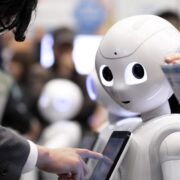Around 30 million devices, machines and products will be networked in 2020 – twice as many as today. These figures from a recent IDC study show the growing influence of the Internet of Things on our economy and society. Intelligent digital networking is rightly regarded as the “key technology of the future”.
In addition to developing exciting consumer applications such as connected cars or smart home solutions, IoT is also redefining industrial processes. No part of the value chain will remain unaffected by the Internet of Things. Whether research & development, production, procurement, logistics, marketing, sales or customer service: intelligent sensors, huge data streams and autonomously acting objects influence the way in which companies work, produce and communicate.
Manufacturing companies are facing the most profound change since the introduction of the assembly line as part of the second industrial revolution. But what specific advantages does IoT offer for process optimization and what changes should companies be prepared for on the way to the Smart Factory?
Internet of Things , IoT, Industry 4.0: what exactly is it all about?
The Internet of Things (IoT for short) refers to a network of devices (so-called “smart devices”) that collect data, communicate independently with one another via the Internet and react depending on the situation. Manual control is largely unnecessary.
Internet of Things: application examples
A wealth of innovative ideas based on IoT arise in every area of daily life. Wearables such as fitness wristbands and data glasses, self-driving cars or refrigerators that automatically reorder scarce groceries are just a small selection of consumer-oriented solutions. Some things still seem science fiction, but the first smart IoT applications are already in use.
In the industrial environment (Industrial Internet of Things / IIoT), machines, materials and products are transformed into “intelligent” objects and thus improve the operational efficiency of production:
- Systems recognize defective components even before they come to a standstill.
- Workpieces automatically look for a free machine for the next work step.
- Packages can be tracked seamlessly across all shipping transport stations.
Internet of Things: The Technology
Thanks to ever smaller, cheaper and energy-saving microprocessors, almost all objects can be equipped with electronic intelligence:
- RFID tags and sensors record operational information such as temperature or fill level.
- Integrated radio modules enable fast wireless data exchange via WLAN, Bluetooth or cellular standards.
- The resulting big data is stored either on local company servers or in the cloud.
Internet of Things: The added value of IoT technologies
The Internet of Things undoubtedly offers a colourful bouquet of new possibilities. But not everything that is technically feasible makes economic sense. Ultimately, it is always about the monetization of the investment: Can we achieve more customer benefits, higher sales, fewer errors, faster delivery, lower costs or more security with IoT? The development from a traditional manufacturing company to a smart factory is therefore not just a technological feat of strength, but also requires economic cost-benefit assessments as well as a strategic vision.
Processes in manufacturing companies: what will change with IoT
IT
In many companies, the technical infrastructure used today is not adequately equipped for the Internet of Things. For intelligent, networked products, a new “technology stack” usually has to be set up.
- Hardware: sensors, processors, radio components
- Software: application software, interfaces, controls
- Network connections for communication between the object and the Internet
- Big data databases
- Analysis tools
- Cloud or server
- Security tools
- Connection to external data sources or other company systems such as ERP
Product development
While product development has so far been heavily engineered, the development teams of modern manufacturing companies have significantly more software developers. The variability of the portfolio increases, model generations give way to continuous product optimization. Digital business models also require expanded thinking beyond the physical product. Smart digital services that increase customer benefits are in demand.
production
The smart factory uses the advantages of new assembly processes and new technologies, whether predictive maintenance, the use of robots or 3-D printing. This makes it possible to cost-effectively produce individualized products down to batch size 1, minimize downtimes and shorten throughput times. APS systems that simulate order scenarios and automatically optimize the production sequence are gaining in importance for the control of intelligent systems.
logistics
The tracking of shipments using RFID labels is already state of the art today. Intelligent IoT applications will continue to revolutionize logistics: Large, scattered delivery fleets are centrally controlled on the basis of real-time data on location, tank range, inspection plans, weather conditions and traffic. Data glasses make order picking easier for warehouse employees, and drones for delivering parcels are already being tested at Amazon, Google and DHL.
marketing & Distribution
The Internet of Things offers marketing completely new opportunities for customer segmentation. On the basis of data from smart devices, companies recognize how customers use the product and which functions are particularly popular. This makes it comparatively easy to develop tailor-made sales offers, attractive after-sales packages or completely new products and additional digital services. Another advantage: prices can be dynamically adjusted to the actual value of the product as perceived by the user.
Aftersales
Thanks to the Internet of Things, support, maintenance and repairs are evolving from a reactive to a proactive service. Efficiency and customer satisfaction increase through remote diagnostics, remote updates and predictive analytics.
Data management
The data volume is becoming significantly larger and more complex due to the Internet of Things. The ability to exploit the full potential of the data collected is becoming an important competitive factor in the digital age . The secure handling of sensitive customer, employee and product data will also play an important role in the future. The collection, administration, analysis and protection of this big data is therefore increasingly bundled in a central department, led by a Chief Data Officer (CDO) who reports to the CEO.
A look into practice: In four steps to Industry 4.0
In order to gain insight into the IoT strategies of German companies, the consulting firm IDC surveyed almost 400 companies with more than 100 employees from eight industries. The core results of the study: Almost three quarters of companies rate the Internet of Things as “very important” or “extremely important”. Nevertheless, the majority of those surveyed are still in the evaluation or planning phase, and only nine percent have fully implemented IoT projects. Frequent reasons for the reluctance of the German manufacturing industry are a lack of budget, a lack of know-how and safety concerns.
In its survey, IDC identified four typical phases in IoT implementation:
- Phase 1: The objects are networked with one another.
- Phase 2: The monitoring of the objects is introduced.
- Phase 3: The companies use the collected data for process optimization.
- Phase 4: The companies transfer the information obtained to their product portfolio and develop new offers and services.
The majority of IoT projects in German SMEs are currently between phase one and three, i.e. the use of the Internet of Things is limited to improving internal processes. The potential to increase customer benefits through networked products and services and thus tap new sources of sales is in most cases still being wasted.
The journey into the IoT future has begun
The first steps have been taken, but the road to a real Smart Factory is still a long one and, according to experts, old and new infrastructures will coexist for years to come. Manufacturing companies that use the opportunities of the fourth industrial revolution and use the Internet of Things as the driving force behind their digital transformation project at an early stage can generate a competitive advantage here.


















Comments